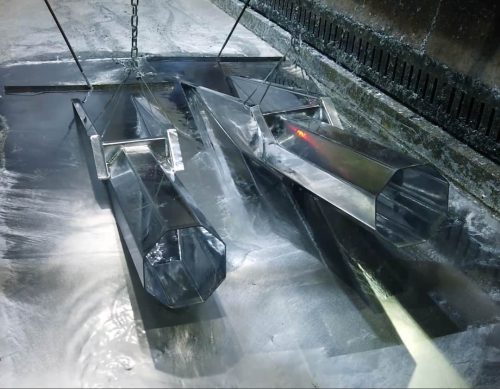Galvanised steel plays a vital role across a wide range of industries, thanks to its exceptional strength, durability, and resistance to corrosion. From construction and infrastructure to agriculture, automotive, and telecommunications, its reliable performance in harsh environments has made it an essential material in modern engineering.
Keep reading to learn about the galvanised steel properties that make this metal so important, its key uses, and how it is made.
What is Galvanised Steel?
Galvanised steel is steel that has been coated with a protective layer of zinc through a process called galvanising. This process helps make the steel corrosion and rust-resistant, offering greater durability in exposed environments. Unlike regular steel, which will eventually rust when exposed to moisture, such as rain or humidity, galvanised steel provides long-term protection, often lasting between 25 and 50 years, depending on environmental conditions.
The Galvanising Process – Methods of Galvanising
Hot-Dip Galvanising
Hot-dip galvanising is the most common method of galvanisation. For this method, steel or iron is dipped in a pool of molten zinc at a temperature of around 460°C. As the metal is withdrawn and exposed to air, the zinc reacts with oxygen to form zinc oxide, which further reacts with carbon dioxide to produce zinc carbonate. The zinc carbonate coats the metal to make up the final protective layer.
The galvanised steel properties resulting from hot-dip galvanising are among the most durable, as this method provides the highest level of protection.
Electrogalvanisation
Electro-galvanising involves bonding a thin layer of zinc to steel using an electric current that is passed through a zinc-based electrolyte solution. The current creates a reaction between the zinc solution and the surface of the steel, leaving a small layer of zinc behind. This method produces a much thinner coating compared to hot-dip galvanising and is typically performed early in the manufacturing process.
Galvannealing
The galvannealing process is similar to hot-dip galvanising. In this process, the metal is once again dipped in molten zinc; however, afterwards, the galvanised steel is reheated to create a zinc-iron alloy, which offers improved paint adhesion and weldability. While this method allows paint to adhere to the surface far better, galvannealed steel offers lower corrosion resistance when compared to hot-dip galvanising due to the thinner coating.
Pre-galvanising
Also similar to the hot-dip method, pre-galvanising is done at the first production stage. Sheet metal is cleaned using a chemical solution to prepare the surface and rapidly passed through molten zinc. This process is well-suited to large-scale galvanising and offers high production efficiency.
Galvanised Steel Characteristics & Benefits
Rust Resistant
The iron elements of steel are incredibly susceptible to rust when exposed to moisture. Zinc acts as a protective barrier, shielding the steel from water and oxygen. Zinc also has self-healing properties. When exposed to air and moisture, zinc forms a layer of zinc oxide, which helps prevent further corrosion.
Durable & Long Lasting
Galvanised steel is known for its strength, durability, and long lifespan. It combines the structural integrity of steel with the corrosion resistance of a zinc-iron coating. This protective layer shields the metal from moisture and other corrosive elements, helping it retain its strength over time.
Depending on the environment, the thickness of the zinc coating and the galvanisation method, galvanised steel can last anywhere from 25-50 years, making it perfect for long-lasting, high-quality poles.
Cost-Effective
Although the initial cost of galvanised steel may be slightly higher than other corrosion protection methods, its long-term savings often outweigh the upfront investment. Its durability means reduced maintenance, fewer repairs, and lower replacement costs over time.
Low Maintenance
Galvanised steel has a longer lifespan than untreated steel, requiring far less maintenance and reducing the need for replacements. Additionally, zinc offers limited self-healing properties. When exposed to oxygen and moisture, it forms a protective zinc-oxide layer that can help protect minor scratches from further corrosion.
Disadvantages
Initial Cost
Galvanised steel can be slightly more expensive than untreated steel or other coated metals. It’s ideal for applications like street light poles, where durability and low maintenance are critical. However, it may be a less practical option for large-scale projects with tight budget constraints.
Limited Aesthetics
Due to the zinc coating, the galvanised steel has a dull grey or mottled appearance. This may not be the most visually appealing, so it will require extra resources to improve its appearance.
White Rust
One of the most common problems with galvanised coatings is “white rust” or “white storage stain”. This usually forms on freshly galvanised steel when it’s exposed to moisture during storage or transport. White rust not only affects the appearance, leaving a chalky or patchy surface, but can also weaken the protective zinc layer, reducing its long-term corrosion resistance.
Common Industries That Use Galvanised Steel
Agriculture
The agricultural industry demands durable, long-lasting materials capable of withstanding harsh conditions. Galvanised steel is an ideal choice due to its excellent corrosion resistance and ability to endure extreme temperatures and challenging environments. Galvanised steel is a reliable and cost-effective option for farming equipment, fencing, sheds and other rural infrastructure.
Construction
Galvanised steel is widely used in both residential and commercial construction due to its strength, superior corrosion resistance, and versatility. Whether chosen for its industrial aesthetic or its structural reliability, it suits a broad range of applications. Common applications might include fencing, gutters, rails, tubing or decorative poles.
Communication
Phone lines, communication poles and towers are not an easy maintenance job. Often, they are incredibly tall and difficult to get to. Galvanised steel’s long-lasting corrosion resistance and durability reduce the need for frequent maintenance, making it an ideal material.
Transportation
From railway signal poles to the bodies of cars, galvanised steel is one of the core metals used within the automotive and transportation industry. Its durability and strong safety performance have made it a preferred choice for manufacturers.
Today, galvanised steel accounts for approximately 80% of the average car body, providing long-lasting corrosion protection, increased security and excellent durability.
Solar Poles
For energy generation, repairs/maintenance mean disruptions to service, and less energy generation. Galvanised steel is a fantastic option for solar poles as it offers long-lasting durability and excellent corrosion resistance. Its ability to withstand harsh environmental conditions is essential to minimise downtime.
Material Properties of Galvanised Steel
| Property | Value |
|---|---|
| Tensile Strength | 520 – 610 MPa |
| Density | 7.85 g/cm³ |
| Hardness | 50-70 HRB |
| Melting Point | 1200°C |
Why Choose G&S Industries
At G&S Industries, we specialise in galvanised steel poles for both commercial and public installations. We are a leading manufacturer of quality poles and columns with one of the largest product ranges in Australia.
If you are interested in using galvanised steel poles for your project or want to know more about our galvanised steel material properties, be sure to contact one of our friendly team members today!

